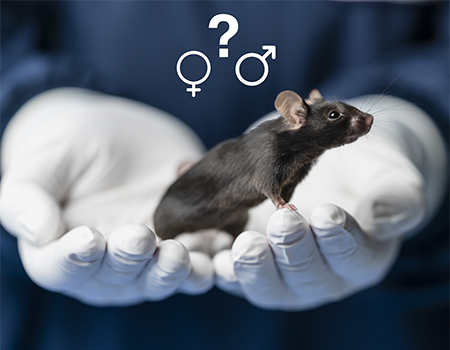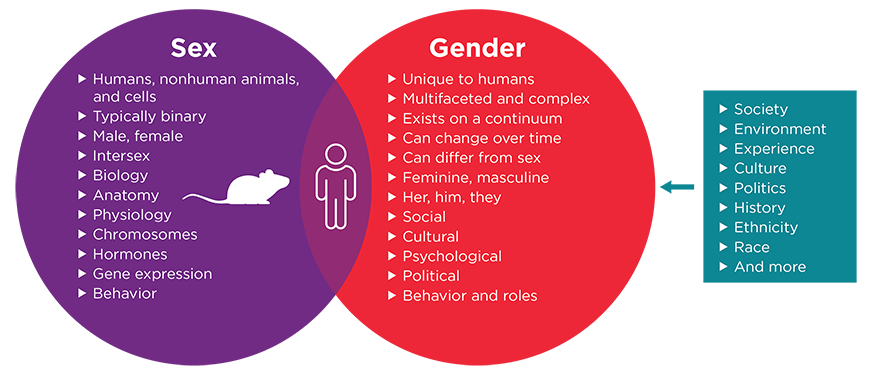 In science, it is of the utmost importance to be precise and accurate with language. It is not uncommon for scientists to operationalize, or define, a term that may vary in meaning across different contexts or research groups. However, when scientists use words incorrectly or interchangeably, this can be confusing and detrimental, particularly if those words actually represent discrete experimental variables. In fact, what if one of the terms could not even be applied in research pertaining to non-human subjects, but investigators used it when referring to their preclinical animal research? One such case that has begun to dominate the research field today is the use, and misuse, of the words sex and gender.
In science, it is of the utmost importance to be precise and accurate with language. It is not uncommon for scientists to operationalize, or define, a term that may vary in meaning across different contexts or research groups. However, when scientists use words incorrectly or interchangeably, this can be confusing and detrimental, particularly if those words actually represent discrete experimental variables. In fact, what if one of the terms could not even be applied in research pertaining to non-human subjects, but investigators used it when referring to their preclinical animal research? One such case that has begun to dominate the research field today is the use, and misuse, of the words sex and gender.
Sex and Gender Terminology
The terms sex and gender are frequently used incorrectly and interchangeably. Gender and sex are related terms, but they are different, and they are not interchangeable. Thus, it is necessary to correctly define and distinguish sex from gender. Dr. Anne Murphy, PhD, a neuroscientist at Georgia State University, defines sex as "biological, chromosomal, XX, XY", whereas gender is "what you view yourself as and what you most associate yourself with." She goes on to say, "That's how I think most people would define it." Dr. Murphy is an expert in this field; for over 30 years she has been studying the impact of sex, age, and stress on pain and the ability of opioids to alleviate pain, and she's right, that's probably how most people would define these terms if asked outright.
But it is not that simple. Although similar and in agreement, several organizations, such as the World Health Organization (WHO) and National Institutes of Health (NIH), have all specified their own definitions of sex and gender, shown verbatim in Appendix Table 1.
Sex is a biological variable with genetic, molecular, physiological, and hormonal properties. Every cell has a sex designated by the presence and number of the X or Y chromosomes. In most cases, this will be XX or XY, and so the classification of sex is typically binary, as male or female1-3.
Sex affects physiological function and hormonal secretion, and it also influences behavior. But behavior is also influenced by external factors, and this is where gender can come into play. Contrary to the definition of sex, gender is even more complex. Dr. Liisa Galea, PhD, a neuroscientist at the University of British Columbia, says "people say gender and they think gender identity, but it's not just gender identity, there is so much more to gender than just gender identity". Dr. Galea is a women's health research advocate and expert in research on how sex and sex hormones influence normal and diseased brain states with a focus on depression and Alzheimer's disease. As illustrated in Appendix Table 1, the definitions of gender are much longer than that of sex for all organizations, clearly demonstrating its intricacy. Gender can also be rooted in biology but refers to socio-cultural and psychological constructs that shape identity, behaviors, roles, traits, and relationships. Whereas sex is typically dimorphic, gender exists on a continuum that is unique to the individual and separate from their biological sex1,2,4-6. Gender is composed of several interconnected aspects. As Dr. Galea mentions, these include not just gender identity, but gender roles/norms, gender relations, and institutionalized gender1,5,7.
Aspects of Gender
- Gender identity: A person's self-representation and presentation and how they are seen and perceived by others; can be context specific.
- Examples: Male, female, other, personality traits, appearance
- Gender roles or norms: Attitudes, expectations, and "rules" that exist in the family, workplace, institutional, or global culture that influence everyday actions.
- Examples: Feminine vs. masculine, familial duties, professions, childcare, aggression, care-giving, dress codes, diet, physical activity, mannerisms
- Gender relations: How people interact with and are treated by other people.
- Examples: Social support, patient reporting, patient/physician interaction
- Institutionalized gender: Distribution of power between people in political, educational, and social institutions within the society.
- Examples: Educational level, personal income, social status, provided opportunities
- Gender identity: A person's self-representation and presentation and how they are seen and perceived by others; can be context specific.
Both sex and gender can be used when referring to humans, but gender is a trait unique to humans. Even though non-human animals are also social creatures, when referring to animal research subjects, particularly focusing on rats and mice for the purposes here, only the term sex should be used. The term gender when referring to in vitro assays such as those interrogating cells and tissues is also incorrect3,8-12.
The appropriate terms that can be applied to either sex or gender are summarized in Figure 1. Not only do gender and sex influence and interact with each other, but gender is also deeply shaped by the environment, prior experiences, society, culture, politics, ethnicity, race, among other factors2,4,7,12. It is important to know the correct definitions of these words, try our best to avoid using them interchangeably, and refrain from using the term gender altogether when referring to preclinical animal research8,9,11.

Figure 1: Comparison of Sex vs. Gender
People often attribute gender stereotypes to animals, and scientists are also guilty of doing this with their experimental subjects. A researcher might say that males are more aggressive, whereas females are timid and easier to work with. When asked how one might debate with someone trying to argue that research animals have gender based on our own gender stereotypes, Dr. Rebecca Shansky, PhD, a neuroscientist at Northeastern University, thinks it just isn't achievable. Rodents do not act certain ways because of how they identify, and there are no methods of knowing how they identify; these behaviors are rooted in biology, and all we can be sure of is their sex. Dr. Shansky is another expert in this field; for over 20 years, she has been studying sex-specific mechanisms of stress-induced changes in learning and memory. Dr. Shansky makes a good point: Gender identity is central to the core definition of gender, and because we cannot engage in a dialog with animals to determine their gender identity, we should only be using the term sex when we refer to them8,11.
The Evolution of the Use of Gender in Preclinical Research
— Dr. Shansky
Even though sex and gender are distinct terms, and animals do not have gender, it is not uncommon for people to refer to animals as having a gender. In fact, people will often refrain from saying the word sex at all, and human research is also not immune to this. When asked why people might say gender instead of sex, Dr. Shansky thinks that people don't like saying the word sex, and it "makes them feel a little funny." Dr. Murphy says, "I think people are embarrassed to say the word sex." People likely think that gender is less taboo, is the politically correct term for sex, and is a more proper or elegant way of referring to biological sex1,6,8,10.
It was not always this way. We didn't always refer to animal research subjects as having genders. But how did we get here? The term gender first appeared in the research literature in the 1950-60s13,14. Since then, the use of both terms has grown over time. A PubMed search for either sex or gender appearing within just the title or abstract of all manuscripts is illustrated in Figure 2. The use of both words has exponentially increased over time. The word sex continues to be predominant, but the use of the word gender has immensely grown, recently nearing almost 80% of the same number of publications observed with sex in the title or abstract within the past two decades, shown in Figure 3.

Figure 2: PubMed Search of Publications Referencing Sex or Gender in the Title and/or Abstract

Figure 3: Percentage of All PubMed Studies Referencing Gender Relative to Sex
The terms sex and gender were, for the most part, accurately distinguished in the literature until the 1980-90s where the two words began to be used interchangeably and as synonyms6,15. While it is possible that many of the clinical publications use the words accurately, the vast majority of these papers use the word gender when they mean sex, and many of them use the mixed term sex/gender when it may be difficult to distinguish between them. It is also the case that authors switch back and forth between the two terms, perhaps as a method of trying to avoid repetition1,6,12,15,16. One report specified that between 1966-1974 only 3.39% of articles used the two words as synonyms, but by 1990-1996, this increased to 56.6%, and it is safe to assume this has been increasing ever since15. This is especially dangerous in the clinical field, considering the terms are actually two distinct experimental variables and can influence results in vastly different ways. However, Dr. Shansky believes that "some people may genuinely believe that the words are interchangeable because they just don't know." This suggests that the recent increase in the term gender relative to sex may reflect a true misunderstanding and lack of appreciation for the distinction between the two terms.
Separate PubMed searches considered whether studies were conducted specifically in mice or rats, with the terms sex or gender again appearing in either just the title or abstract. As shown in Figure 4, the use of gender appears in the 1980-90s and increases over time. It is still too early to tell, but the use of gender might be plateauing, whereas the use of sex is continuing to increase in preclinical research. However, these publications are just those where these terms are included specifically in the title or abstract, and not in the methods section, where there may be an even higher likelihood of appearance. Similar results have been found previously using other search engines or within specific journals for the data shown in both Figures 3 and 4, and in most cases, reports using gender were confirmed to actually be sex-based studies6,8,15,17.

Figure 4: PubMed Search Results of Sex and Gender in Titles and/or Abstracts for Studies in Mice and Rats
When asked whether the situation is getting worse, both Drs. Murphy and Shansky think it's getting better and that the plateau in the use of gender may be real. Dr. Shansky thinks that if the frequency of the use of gender is continuing to increase, it may be as a result of more and more people now studying sex differences that had not previously, and so they may not know how to talk about it. There is certainly a case for this; the use of these terms in preclinical research has vastly increased over the years because more researchers are studying both males and females. But that's a whole other discussion for a different day, which will be tackled in a secondary companion Insight to this one.
Going Forward
What can we do when we hear someone refer to animal research subjects as having gender? Dr. Murphy wants to immediately correct people, she tells them, "I think you mean sex." Dr. Shansky says, "I just tell them that's inaccurate...gender is an identity. We can't ask the animals how they identify, and so we're going to say sex because that's the only way we truly know to classify them."
The National Academy of Medicine (formally the Institute of Medicine (IOM)) was the first major organization to call attention to the misuse of these words in both the scientific literature and the popular press18. The IOM Committee on Understanding the Biology of Sex and Gender Differences gave clear definitions for both terms and provided guidelines for both human and animal research, emphasizing that only the word sex should be used in preclinical research18. Although that call to action was over 20 years ago, the misuse and misinterpretation of these terms has continued to increase.
Dr. Murphy mentioned that she constantly corrects investigators during peer review processes and grant submissions, but she doesn't know what else to do to get the word out there. Peer reviewers and journal editors are the gatekeepers of publications, and they have an opportunity and responsibility to ensure proper terminology is utilized1. Unfortunately, it has been commonplace for editors to actually replace the term sex with gender during the copy-editing process of already-accepted manuscripts8. Several journals6,19,20 and even institutes16,21 have adopted policies and recommendations on the reporting of sex and gender in research, but the majority do not. Many publications also serve as a plea to journals to take accountability for this issue and provide guidelines to both editors and investigators on this topic1,7,19-25. Specifically, the Sex and Gender Equity in Research (SAGER) guidelines was designed with the goal of guiding both authors and editors to use correct terminology24. Together, these guidelines may contribute to the declining use of "gender" in preclinical research.
One commentary has even gone as far as to making an open petition for scientists to stop using the word gender when referring to animal research11. In their commentary, the author specifically called out one publication as an example that had gender in the title of an article studying both male and female mice. Further, the article in question also used the terms gender and sex interchangeably throughout11. Even though a specific article was called out, those authors did not reinstate a correction. Both Drs. Murphy and Shansky confirm that it takes a lot of effort, perseverance, and time to submit a correction or corrigendum for a publication, sometimes up to several months. A PubMed search resulted in just one corrigendum dealing with this exact issue where the authors initially had the term gender in their publication referring to a study in mice26. These authors stated that due to the definition of gender by WHO, the correct term that should have been used in their paper was sex and not gender, and they were sorry for any inconveniences26. This action is both surprising and applaudable.
It is worthwhile noting that the misuse of these terms is a great disservice to the clinical literature where they actually represent different experimental variables. There are many examples in research where there were specific sex or gender effects in several chronic diseases4. For example, a landmark study has been used to illustrate the importance of gender instead of sex when assessing outcomes of cardiovascular disease27. This sheds light on the fact that, in humans, gender can influence access to health care, health-seeking behaviors, and the use of preventative measures. The interchangeable use of these terms can cause confusion not only in the scientific community but also among the general public, stakeholders, policymakers, and government agencies, ultimately leading to a delay in scientific progress4,9,23.
What Does this Mean for Model Generation Providers and Preclinical Researchers?
Taconic Biosciences is a leading model provider with extensive expertise in the application of mice and rats for in vivo preclinical research. Dr. Phil Dubé, PhD, senior scientist and associate director of global applications sciences at Taconic, believes that "the proper use of the terms sex and gender at Taconic not only demonstrates scientific leadership, but also shows sensitivity to an issue that is important for many in the research community, not to mention being in line with our own internal goals to promote diversity and inclusion."
Ultimately, the use of the term gender in preclinical literature leads to confusion, controversy, and misrepresentation of the conclusions resulting from research findings. One of the first steps in conducting good science is using the correct terminology. We can all help spread this message by using the word "sex" when referring to preclinical animal models.
| Organization | Sex Definition | Gender Definition | Reference |
| World Health Organization (WHO) | "Different biological and physiological characteristics of females, males and intersex persons, such as chromosomes, hormones and reproductive organs" | "Characteristics of women, men, girls and boys that are socially constructed. This includes norms, behaviours and roles associated with being a woman, man, girl or boy, as well as relationships with each other. As a social construct, gender varies from society to society and can change over time" | World Health Organization |
| National Academy of Medicine (NAM), formally Institute of Medicine (IOM) | "Classification of living things, generally as male or female, according to their reproductive organs and functions assigned by chromosomal complement" | "A person's self-representation as male or female, or how that person is responded to by social institutions on the basis of the individual's gender presentation. Gender is rooted in biology and shaped by environment and experience." | National Academy of Medicine |
| Society for Women's Health Research (SWHR) | "Classification of living things, generally as male or female, according to their reproductive organs and functions assigned by chromosomal complement" | "Social, cultural, and environmental influences on the biological factors of women or men. Gender is rooted in biology and shaped by environment and experience. | Society for Women's Health Research |
| Global Health 5050 | "Women and girls, or men and boys" | "Gender is not equivalent to women and girls, or men and boys, but encompasses people of all genders and sexual orientations. It is socially constructed and influenced by laws, politics, policies, communities, families and individuals. It shapes how we behave, act and feel. Gender determines our positions and roles in society. It impacts health and wellbeing, influencing both our own individual behaviours -what risks we take with our health, what risks we face and whether or not we seek health care - and how the health system responds to our needs when we are sick or need care and support." | Global Health 5050 |
| National Institute of Health (NIH) | "Biological differences between females and males, including chromosomes, sex organs, and endogenous hormonal profiles" | "Socially constructed and enacted roles and behaviors which occur in a historical and cultural context and vary across societies and over time" | National Institutes of Health |
| Canadian Institutes of Health Research (CIHR) | "Set of biological attributes in humans and animals. It is primarily associated with physical and physiological features including chromosomes, gene expression, hormone levels, and reproductive/sexual anatomy. Sex is usually categorized as female or male but there is variation in the biological attributes that comprise sex and how those attributes are expressed." | "The socially constructed roles, behaviours, expressions and identities of girls, women, boys, men, and gender diverse people. It influences how people perceive themselves and each other, how they act and interact, and the distribution of power and resources in society. Gender identity is not confined to a binary (girl/woman, boy/man) nor is it static; it exists along a continuum and can change over time. There is considerable diversity in how individuals and groups understand, experience and express gender through the roles they take on, the expectations placed on them, relations with others and the complex ways that gender is institutionalized in society." | Canadian Institutes of Health Research |
| European Institute for Gender Equality (EIGE) | "Biological characteristics which define humans as female or male. These sets of biological characteristics are not mutually exclusive as there are individuals who possess both, but these characteristics tend to differentiate humans as males and females." | "Gender refers to the social attributes and opportunities associated with being male and female and the relationships between women and men and girls and boys, as well as the relations between women and those between men. These attributes, opportunities and relationships are socially constructed and are learned through socialization processes. They are context/ time-specific and changeable. Gender determines what is expected, allowed and valued in a woman or a man in a given context. In most societies there are differences and inequalities between women and men in responsibilities assigned, activities undertaken, access to and control over resources, as well as decision-making opportunities. Gender is part of the broader socio-cultural context. Other important criteria for socio-cultural analysis include class, race, poverty level, ethnic group and age." | European Institute for Gender Equality |
| Office for National Statistics (ONS) (UK government) | "Referring to the biological aspects of an individual as determined by their anatomy, which is produced by their chromosomes, hormones and their interactions; generally male or female; something that is assigned at birth" | "A social construction relating to behaviours and attributes based on labels of masculinity and femininity; gender identity is a personal, internal perception of oneself and so the gender category someone identifies with may not match the sex they were assigned at birth; where an individual may see themselves as a man, a woman, as having no gender, or as having a nonbinary gender - where people identify as somewhere on a spectrum between man and woman" | Office for National Statistics (UK Government) |
Appendix Table 1: Definitions of Sex and Gender Across Organizations
References:
1. Blakeman, J. R., Words Matter: Sex and Gender as Unique Variables in Research. ANS Adv Nurs Sci 2020, 43 (3), 214-227.
2. Holdcroft, A., Integrating the dimensions of sex and gender into basic life sciences research: methodologic and ethical issues. Gender Medicine 2007, 4, S64-74.
3. Silver, R., Cells have sex chromosomes and circadian clocks: Implications for organismal level functions. Physiol Behav 2018, 187, 6-12.
4. Mauvais-Jarvis, F.; Bairey Merz, N.; Barnes, P. J.; Brinton, R. D.; Carrero, J.-J.; DeMeo, D. L.; De Vries, G. J.; Epperson, C. N.; Govindan, R.; Klein, S. L.; Lonardo, A.; Maki, P. M.; McCullough, L. D.; Regitz-Zagrosek, V.; Regensteiner, J. G.; Rubin, J. B.; Sandberg, K.; Suzuki, A., Sex and gender: modifiers of health, disease, and medicine. The Lancet 2020, 396 (10250), 565-582.
5. Tannenbaum, C.; Greaves, L.; Graham, I. D., Why sex and gender matter in implementation research. BMC Med Res Methodol 2016, 16 (1), 145.
6. Torgrimson, B. N.; Minson, C. T., Sex and gender: what is the difference? J Appl Physiol (1985) 2005, 99 (3), 785-7.
7. Johnson, J. L.; Greaves, L.; Repta, R., Better science with sex and gender: Facilitating the use of a sex and gender-based analysis in health research. Int J Equity Health 2009, 8, 14.
8. Goymann, W.; Brumm, H., Let's Talk About Sex - Not Gender. Bioessays 2018, 40 (5), e1800030.
9. Madsen, T. E.; Bourjeily, G.; Hasnain, M.; Jenkins, M.; Morrison, M. F.; Sandberg, K.; Tong, I. L.; Trott, J.; Werbinski, J. L.; McGregor, A. J., Article Commentary: Sex- and Gender-Based Medicine: The Need for Precise Terminology. Gender and the Genome 2017, 1 (3), 122-128.
10. Mauvais-Jarvis, F.; Arnold, A. P.; Reue, K., A Guide for the Design of Preclinical Studies on Sex Differences in Metabolism. Cell Metab 2017, 25 (6), 1216-1230.
11. Richie, C., Sex, not gender. A plea for accuracy. Exp Mol Med 2019, 51 (11), 1.
12. Ritz, S. A.; Antle, D. M.; Cote, J.; Deroy, K.; Fraleigh, N.; Messing, K.; Parent, L.; St-Pierre, J.; Vaillancourt, C.; Mergler, D., First steps for integrating sex and gender considerations into basic experimental biomedical research. FASEB J 2014, 28 (1), 4-13.
13. Money, J.; Hampson, J. G.; Hampson, J. L., Imprinting and the establishment of gender role. A.M.A. Archives of Neurology and Psychiatry 1956, 333-336.
14. Stoller, R. J., A contribution to the study of gender identity. The International Journal of Psychoanalysis 1964, 45 (2-3), 220-226.
15. Walker, P. L.; Cook, D. C., Brief Communication: Gender and Sex: Vive la Difference. American Jornal of Physical Anthropology 1998, 106, 255-259.
16. Johnson, J.; Sharman, Z.; Vissandjee, B.; Stewart, D. E., Does a change in health research funding policy related to the integration of sex and gender have an impact? PLoS One 2014, 9 (6), e99900.
17. Haig, D., Of sex and gender. Nature Genetics 2000, 25, 373.
18. Wizeman, T. M.; Pardue, M.; Medicine, I. o., Exploring the biological contributions to human health: Does sex matter? Press, N. A., Ed. Washington, Dc: The National Academies Press, 2001.
19. Cavanaugh, C.; Abu Hussein, Y., Do journals instruct authors to address sex and gender in psychological science? Res Integr Peer Rev 2020, 5, 14.
20. Thompson, K.; Peters, S.; Woodward, M.; Carcel, C.; Norton, R., Reporting sex and gender in medical research. The Lancet 2019, 393 (10185).
21. Clayton, J. A.; Tannenbaum, C., Reporting Sex, Gender, or Both in Clinical Research? JAMA 2016, 316 (18), 1863-1864.
22. Lawrence, K.; MPH B.; Rieder, A., Gender Medicine 2007, 4, S96-S105.
23. Tannenbaum, C.; Ellis, R. P.; Eyssel, F.; Zou, J.; Schiebinger, L., Sex and gender analysis improves science and engineering. Nature 2019, 575 (7781), 137-146.
24. Heidari, S.; Babor, T. F.; De Castro, P.; Tort, S.; Curno, M., Sex and Gender Equity in Research: rationale for the SAGER guidelines and recommended use. Res Integr Peer Rev 2016, 1, 2.
25. Prins, M. H.; Smits, K. M.; Smits, L. J., Methodologic ramifications of paying attention to sex and gender differences in clinical research. Gender Medicine 2007, 4, S106-S110.
26. Qi, L.; Kogiso, M.; Du, Y.; Zhang, H.; Braun, F. K.; Huang, Y.; Teo, W. Y.; Lindsay, H.; Zhao, S.; Baxter, P.; Zhao, X.; Yu, L.; Liu, Z.; Zhang, X.; Su, J.; Adesina, A.; Yang, J.; Chintagumpala, M.; Perlaky, L.; Tsz-Kwong Man, C.; Lau, C. C.; Li, X. N., Corrigendum to "Impact of SCID mouse gender on tumorigenicity, xenograft growth and drug-response in a large panel of orthotopic PDX models of pediatric brain tumors" [Cancer Lett. 493 (2020) 197-206]. Cancer Lett 2021, 500, 294.
27. Pelletier, R.; Khan, N. A.; Cox., J.; Daskalopoulou, S. S.; Eisenberg, M. J.; Bacon, S. L.; Lavoie, K. L.; Daskupta, K.; Rabi, D.; Humphries, K. H.; Norris, C. M.; Thanassoulis, G.; Behlouli, H.; Pilote, L., Sex versus gender-related characteristics: which predicts outcome after acute coronary syndrome in the young. Journal of the American College of Cardiology 2016, 67 (2), 127-135.
















.jpg)

.jpg)
.jpg)
.jpg)
.jpg)





.jpg)


.jpg)
.jpg)




.jpg)




.jpg)

.jpg)



